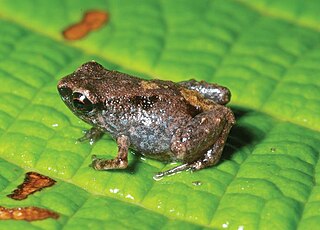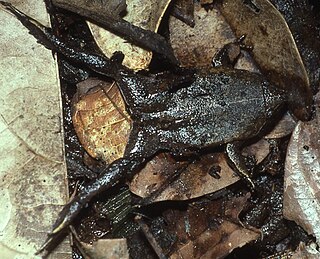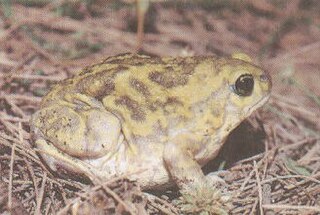
The Microhylidae, commonly known as narrow-mouthed frogs, are a geographically widespread family of frogs. The 683 species are in 57 genera and 11 subfamilies.

Plethodontohyla is a genus of microhylid frogs endemic to Madagascar.

Asterophryinae is a subfamily of microhylid frogs distributed in an area from the Peninsular Malaysia through the Malay Archipelago to northern Australia.
Hylophorbus is a genus of microhylid frogs endemic to New Guinea. Common name Mawatta frogs has been coined for them.

Xenorhina is a genus of microhylid frogs. The genus is endemic to New Guinea. They are sometimes known as the snouted frogs or fanged frogs, the latter referring to the now-synonymized genus Xenobatrachus.

Choerophryne is a genus of microhylid frogs, commonly known as Torricelli mountain frogs, endemic to New Guinea. These frogs are small, with the body length measured from snout to vent between 11 and 23 mm.
Copiula is a genus of microhylid frogs endemic to New Guinea. The common name Mehely frogs has been coined for them. They are leaf-litter inhabitants.

Ctenophryne is a genus of microhylid frogs. They occur in southern Central America and South America. Their common names are egg frogs and Nelson frogs, the latter applying to species in the formerly recognized Nelsonophryne.

Uperodon is a genus of microhylid frogs. They occur in South Asia and Myanmar. Uperodon reached its current composition in 2016 when the genus Ramanella was brought into its synonymy. The common names of these frogs are globular frogs and balloon frogs in reference to their stout appearance, or dot frogs, the last specifically referring to the former Ramanella.
Austrochaperina adamantina is a species of frog in the family Microhylidae. It is endemic to New Guinea and occurs in the Torricelli and Bewani Mountains in the West Sepik Province, Papua New Guinea. The specific name adamantina is Latin for "like a diamond" and refers to Jared Diamond, credited as the collector of the holotype and "great many other valuable herpetological specimens from Papua New Guinea".
Austrochaperina brevipes is a species of frog in the family Microhylidae. It is endemic to Papua New Guinea and known only from two localities, Mount Victoria and Myola Guest House in the Owen Stanley Range. Common name Victoria land frog has been suggested for it.

Copiula derongo is a species of frog in the family Microhylidae. It is endemic to New Guinea and found in both Indonesia and Papua New Guinea. The specific name derongo refers to its type locality, the village of Derongo in the Western Province. Based on molecular evidence, it was transferred from Austrochaperina to Copiula in 2016.

Copiula guttata is a species of frog in the family Microhylidae. It is endemic to Papua New Guinea and known from around the head of the Gulf of Papua in the Gulf and Chimbu Provinces. The specific name is the Latin adjective guttata that means "spotted" and refers to the dorsal colour pattern of this species. Based on molecular evidence, it was transferred from Austrochaperina to Copiula in 2016.

Copiula rivularis is a species of frog in the family Microhylidae. It is endemic to Papua New Guinea and known from near the Indonesian border east to the Morobe Province; it is expected to occur in the Papua province of Indonesia. The specific name comes from the Latin adjective pertaining to small brooks or streams and refers to the habitat of this species. Based on molecular evidence, it was transferred from Austrochaperina to Copiula in 2016.
Callulops boettgeri, also known as Boettger's Callulops frog, is a species of frog in the family Microhylidae. It is endemic to Halmahera in the Maluku Islands of Indonesia. It is only known from the holotype collected from Galela in 1894. The genus-level placement of this little known frog has changed many times, and it is still unclear whether it should be placed in some other genus.

Glyphoglossus is a genus of frogs in the family Microhylidae. The genus occurs in Southeastern Asia. Common name balloon frogs has been coined for it, whereas the common name squat frogs refers to the Calluella species that are now included in this genus. They are fossorial frogs that spend only limited time on the soil surface and are typically known from only few specimens.
Copiula alpestris is a species of frog in the family Microhylidae. It is endemic to Papua New Guinea and known from the Western Highlands, Chimbu, and Eastern Highlands Provinces at elevations of 1,800–2,800 m (5,900–9,200 ft) above sea level. The specific name is a Latin adjective meaning "living in high mountains", in reference to its relatively high-altitude habitats. Based on molecular evidence, the species was transferred from Oxydactyla to Copiula in 2016.

Sphenophryne cornuta is a species of frogs in the family Microhylidae. It is endemic to New Guinea where it is widespread and found both in the Western New Guinea (Indonesia) and Papua New Guinea. Common name horned land frog has been proposed for it.
Sphenophryne is a genus of frogs in the family Microhylidae from New Guinea. It reached its current composition in 2017 when Rivera and colleagues brought the genera Genyophryne, Liophryne, and Oxydactyla into synonymy of the then-monotypic Sphenophryne. However, the AmphibiaWeb continues to recognize these genera as valid.












